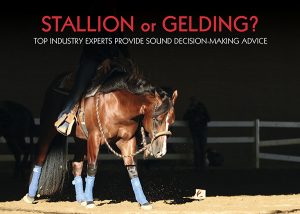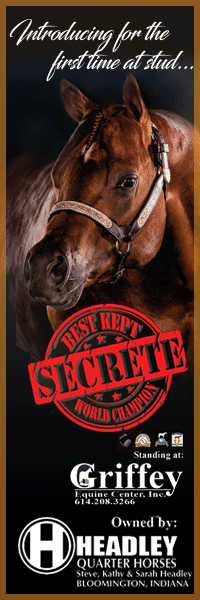Stallion or Gelding?
Click here to read the complete article
 By Delores Kuhlwein
By Delores Kuhlwein
How do you know if a foal, still on its dam, has the potential to become one of those truly special, life-defining horses? Determining the future of a young colt–and whether it has what it takes to become a breeding sire, or whether it should be gelded–isn’t an exact science, but experienced horsemen know there are certain indicators that differentiate a noteworthy stallion from a superior gelding.
Read on for insight into what qualities successful stallion owners and breeding managers look for when determining if a young foal should remain a colt or become a gelding, and how they know if a prospect has what it takes to become a stallion.
Must-Haves
There are a few basics to consider when determining whether a horse has the potential to be a stallion. “In working and show, we strive for short backs, low hocks, solid feet, and necks that tie in right,” explains Hillary Roberts, Stallion Manager of Hay Goodlookn and Business Manager of her family-owned business, Capital Quarter Horses in Pilot Point, Texas. “When we choose a stallion for our mare, we should look for where his strengths can fill in for any conformational weaknesses she may have. A stallion that’s built right, with few physical shortcomings himself, will be able to do that in almost every case.”
Similarly, Stephen Stephens, Trainer and Co-Founder of Dry River Ranch in Weatherford, Texas, says physical characteristics are central to a decision about a young colt. “Your first ideals should be conformation, balance, and bone structure, and whether he meets the basic description of a balanced Halter horse,” he says. In addition, the past president of the National Snaffle Bit Association and carded AQHA and NSBA judge reveals that eye appeal, movement, and disposition are also crucial factors.
Mike Augustyn, industry horseman, breeder, and Assistant Breeding Manager of Allocate Your Assets, Nothin But Nett, and VS Code Blue for Circle S Ranch in Scottsdale, Arizona, explains that a prospective stallion must possess what he calls “harmony.” This is the unique combination of correctness, and the topline necessary for Hunt Seat or Western Pleasure, along with the right movement and swing of the shoulder. He explains, “I also tend to like to see horses on the loose to evaluate their movement, so seeing them turned out is the ideal preference.”
All three agree that temperament is a key attribute of a great stallion. Augustyn says he’s looking for “a good-minded colt that always has his ears forward and is cooperative on the ground.” Roberts concurs and says, “A good mind is of the utmost importance. If the horse isn’t trainable and good to handle, it’s hard to expect his offspring to be any different. I believe looking at a stallion’s show record is a good way to gauge his mind and trainability. Not all stallions have a lengthy show record, or have been shown at all, and there’s nothing wrong with that whatsoever. But, I think it speaks to both his talent and his temperament if he was successfully shown. Even better if he was successfully shown by a Non-Pro exhibitor!”
Our readers might be surprised to learn that pedigree isn’t necessarily of the utmost importance. Both Stephens and Augustyn say it’s valuable, but it’s not everything. “Eye appeal and balance will outweigh any pedigree,” Stephens says. Augustyn adds, “I find breeding to be important on the mare’s side, but it only holds so much weight. You have to look at the individual, too. Even though it’s situational, I think the ability to prove out the horse in the show pen is the ultimate test of who the horse is.”
Above the Rest










